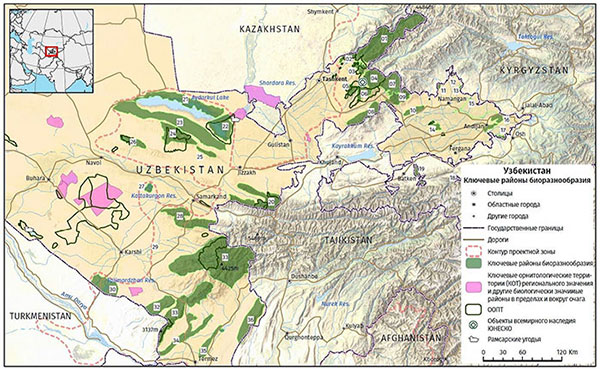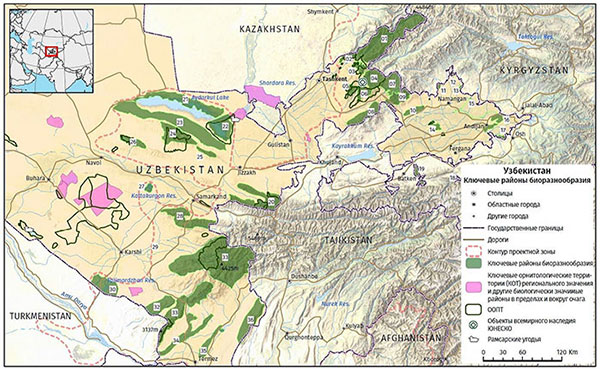WWF Central Asia is serving as the regional implementation team for the hotspot, is accepting project proposals from non-government organizations, community groups, cultural organizations, women’s groups, private companies and other civil society organizations for projects per the requirements listed here.
BACKGROUND
The Critical Ecosystem Partnership Fund (CEPF) is a joint initiative of l’Agence Française de Développement, Conservation International, the European Union, the Global Environment Facility, the Government of Japan and the World Bank. A fundamental goal is to ensure civil society is engaged in biodiversity conservation.
The Mountains of Central Asia Biodiversity Hotspot consists of two of Asia’s major mountain ranges, the Pamir and the Tien Shan. Politically, the hotspot’s 860,000 square kilometers include southern Kazakhstan, most of Kyrgyzstan and Tajikistan, eastern Uzbekistan, western China, northeastern Afghanistan, and a small part of Turkmenistan. CEPF’s investment focuses on Key Biodiversity Areas (KBAs), defined as “sites contributing significantly to the global persistence of biodiversity”, as well as priority species and corridors.
WWF serves as the Regional Implementation Team (RIT) and manages a small grant program to support projects up to $20,000. Recipients of small grants will receive agreements from WWF reflecting the requirements of CEPF.
Applicants are strongly encouraged to familiarize themselves with the RIT website, www.mca.earth and the CEPF website, particularly the sections on Eligibility and Before You Apply.
ELIGIBLE APPLICANTS
Non-governmental and non-commercial civil society organizations, registered community groups and citizen cooperatives, and private universities may apply for funding. It is possible for commercial organizations, such as farms and to apply for funding by special consideration. Individuals must work with civil society organizations rather than apply directly.
International organizations are encouraged to involve local organizations or communities as project partners and/or explain how local stakeholders will be engaged as part of project implementation.
Organizations must have their own bank account and be authorized under relevant national laws to receive charitable contributions. Groups without a USD bank account may partner with other organizations that do have a USD bank account.
Government-owned enterprises or institutions are eligible only if they can demonstrate that the enterprise or institution has:
- a legal personality independent of any government agency or actor;
- the authority to apply for and receive private funds; and
- may not assert a claim of sovereign immunity.
Grants cannot be used for:
- the purchase of land, involuntary resettlement of people, or activities that negatively affect physical cultural resources, including those important to local communities.
- activities adversely affecting indigenous peoples or where these communities have not provided their broad support to the project activities.
- removal or alteration of any physical cultural property (includes sites having archaeological, paleontological, historical, religious, or unique natural values).
PRIORITY ACTIVITIES AND GEOGRAPHIC AREAS
Projects should be organized to address the strategic directions and investment priorities in the table below and also described in pages 123 – 137 of the Ecosystem Profile.
| Strategic direction | Investment priorities |
| 1. Address threats to priority species | 1.1. Improve enforcement and develop incentives and
alternatives for nature users and collectors
1.2. Promote improved regulation of collecting, hunting, and fishing
1.3. Support the development of species-specific reserves and conservation programs
1.4. Prevent human-wildlife conflict by addressing killing, poisoning, and trapping
1.5. Maintain populations of priority species beyond those solely affected by collection, hunting, fishing, poisoning, and nature users
|
| 2. Improve management of priority sites with and without official protection status | 2.1. Facilitate effective collaboration among CSOs, local communities, and park management units to enhance protected area networks
2.2. Develop and implement management approaches to sustainable use in KBAs outside official protected areas
2.3. Build support and develop capacity for identification and recognition of KBAs
|
| 3. Support sustainable management and biodiversity
conservation within priority corridors |
3.1. Develop protocols and demonstration projects for
ecological restoration that improve the biodiversity performance and connectivity of KBAs
3.2. Evaluate and integrate biodiversity and ecosystem service values into land-use and development planning
3.3. Support civil society efforts to analyze development plans and programs, evaluate their impact on biodiversity, communities and livelihoods, and propose alternative scenarios and appropriate mitigating measures
|
| 4. | 4.2. Promote mainstreaming of conservation into
livestock and farm management practices |
Projects should address any of the following priority geographies:
- KBA 4: Akbulak River Basin
- KBA 5: Bashkyzylsai River Basin
- KBA 6: Karabau and Dukentsay River Basins
- KBA 24: Nuratau Ridge
- KBA 30: Talimarjan Reservoir
- Corridor 7: Turkestan and Alai Mountains
- Corridor 9: Western Tien Shan
Regarding KBA 4, 5, 6, and 24, we expect projects that focus on threatened and endemic species protection and research, engagement of local nature users and capacity building for more effective functioning of KBA. Additionally, for KBAs 4 and 5, project can include awareness work in relation to UNESCO World Heritage site status, and cross-border cooperation.
Regarding KBA 30, we expect projects that focus on protection of threatened species and globally significant aggregations.
The RIT will accept proposals that partially take place outside of these named priority KBAs and corridors if the project otherwise fulfils priorities listed in the Ecosystem Profile.
Priority will be given to projects that do not compete with existing projects on individual species. Instead, preference will be given to those projects that focus on larger ecosystem conservation surrounding a KBA or corridor, that replicate proven past methods, and build collaboratively on the work of others.

Key Biodiversity Areas (KBAs) of Uzbekistan
TIMEFRAME
Projects are expected to start in 2021. Typical duration will be one or two years, but all CEPF-funded work must be complete by June 2024.
HOW TO APPLY
Applicants should complete proposals and budgets per the templates available at the Grantee Portal, www.mca.earth.
Proposals can be written in English or Russian.
Applicants must submit their completed proposal and budget by the deadline via electronic mail to:
Tatyana Reznikova, Small-Grants Manager, tatyana@argonet.org
Please copy:
Aleksnadr Grigoryants, Uzbekistan Country Coordinator, a.grigor50@mail.ru
in your message.
You will receive an acknowledgement from the RIT confirming your submission.
The review process will take approximately 6 weeks from the deadline date. The review committee will select the strongest proposals which meet the eligibility criteria, as shown in the Expert Evaluation Form.
Selected proposals will be awarded a small grant, with an agreement made between WWF as the RIT for the Mountains of Central Asia Hotspot, and the applicant’s institution (the “Grantee”). We reserve the right to request that the Grantee make changes to the project and planned activities, should such changes be recommended by our panel of experts. Grants will be denominated in United States dollars and grant agreements will be in English or Russian. A sample Grant agreement letter can be found on the Grantee Portal at www.mca.earth.
REFERENCE MATERIALS
All applicants are advised to review the CEPF Ecosystem Profile for the Mountains of Central Asia, which serves as the strategy document for CEPF investment in the Hotspot and provides more detail on the types of activity CEPF will fund under each Investment Priority.
CEPF is committed to integrating gender into its portfolio. Applicants should design projects and write proposals that consider gender issues in the achievement of their conservation impacts. CEPF has developed several resources that can help applicants to design, implement and evaluate gender-aware projects (CEPF Gender Toolkit) and understand what CEPF seeks in a proposal (CEPF Gender Fact Sheet). Visit the CEPF and Gender webpage to learn more about how CEPF addresses gender in the projects it supports. CEPF will evaluate your project based on its integration of gender.
All projects must be in line with the Safeguard policies. They can be found here, and on the Grantee Portal.
Additional resources:
- Before You Apply
- 12 Tips for Getting Your Grant Idea Funded
- CEPF Project Database
- Life Cycle of a Grant
CONTACT
Before submitting your letter of inquiry, we encourage you to discuss your eligibility and project idea with us. Please contact:
- Aleksandr Grigoryants, +998 93-184-33-92, a.grigor50@mail.ru
- Tatyana Reznikova, Small-Grants Manager: tatyana@argonet.org
- Lizza Protas, RIT Team Leader: LProtas@fondprirody.ru

